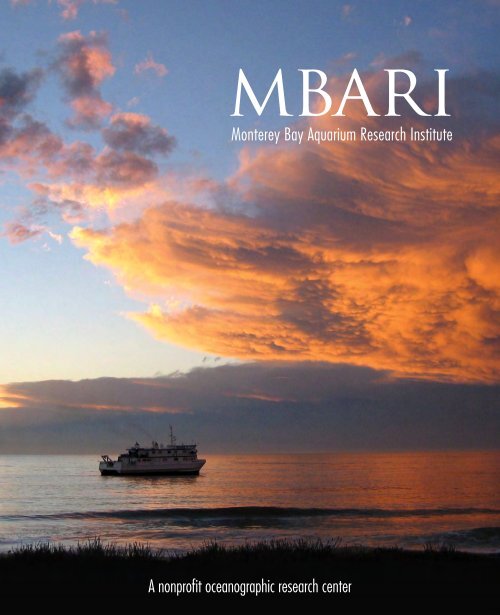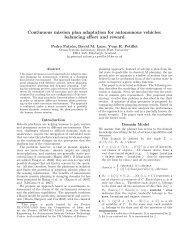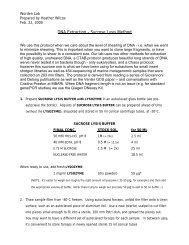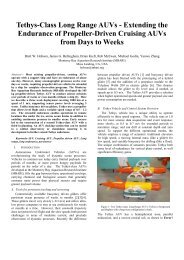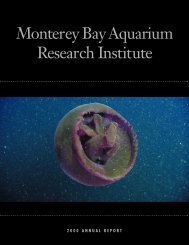Brochure about MBARI (PDF) - Monterey Bay Aquarium Research ...
Brochure about MBARI (PDF) - Monterey Bay Aquarium Research ...
Brochure about MBARI (PDF) - Monterey Bay Aquarium Research ...
Create successful ePaper yourself
Turn your PDF publications into a flip-book with our unique Google optimized e-Paper software.
A nonprofit oceanographic research center
esearch programs at the <strong>Monterey</strong> <strong>Bay</strong><br />
<strong>Aquarium</strong> <strong>Research</strong> Institute (<strong>MBARI</strong>)<br />
encompass the entire ocean, from the surface<br />
waters to the deep seafloor, and from the coastal<br />
zone to the open sea.<br />
The more we learn <strong>about</strong> seafloor geology,<br />
ocean life, and marine chemistry, the better we<br />
can understand human impacts on the ocean<br />
and the influence of the ocean on all life on<br />
Earth. This need to understand the ocean in all<br />
its complexity and variability drives <strong>MBARI</strong>’s<br />
research and development efforts. Scientists<br />
and engineers team up to determine the<br />
most pressing ocean science questions, then<br />
create the instruments and methods to resolve<br />
those mysteries.<br />
Founded in 1987 by David Packard, <strong>MBARI</strong><br />
continues to receive substantial support from<br />
the David and Lucile Packard Foundation. This<br />
ongoing funding enables the nonprofit institute<br />
to take on high-risk projects, as well as long-term<br />
◀ Advanced sensors on simple floats are deployed<br />
around the world to collect information <strong>about</strong> changing<br />
ocean chemistry.<br />
◀ High-definition video cameras on <strong>MBARI</strong>’s remotely<br />
operated vehicles (ROVs) provide views of unfamiliar<br />
animals and behaviors, such as this Octopoteuthis<br />
squid.<br />
◀ <strong>Monterey</strong> Canyon plunges to depths greater than<br />
4,000 meters, providing researchers with easy access<br />
to the deep sea. Detailed seafloor maps are created<br />
with data collected by the institute’s advanced mapping<br />
autonomous underwater vehicles (AUVs).
studies that traditional granting agencies may be<br />
reluctant to fund. <strong>MBARI</strong>’s work contributes to the<br />
Packard Foundation’s goal to restore the health and<br />
productivity of the world ocean.<br />
<strong>MBARI</strong> researchers pursue a range of challenging<br />
problems, such as how the tiniest microbial<br />
organisms affect other sea life, causes and<br />
consequences of geological disturbances on the<br />
seafloor, and how the chemistry of ocean surface<br />
waters affects the food available to animals living<br />
thousands of meters below on the deep seafloor.<br />
The creation of new sensors for observing the ocean<br />
and systems for conducting experiments at sea are<br />
hallmarks of <strong>MBARI</strong>’s achievements. The capacity to<br />
develop and quickly test new technologies, then put<br />
these new tools to use for science, distinguishes the<br />
institute in the oceanographic community.<br />
<strong>MBARI</strong> addresses issues of global and societal<br />
relevance within the following research themes:<br />
Ocean visualization—creating representations<br />
of the ocean’s interior, its inhabitants, and its<br />
bottom topography.<br />
Ecosystem dynamics—studying complex<br />
interactions between microorganisms and the<br />
transfer of nutrients between the ocean surface<br />
and the deep sea.<br />
Ocean biogeochemistry—reaching an<br />
understanding of global-scale processes by<br />
recording variations in ocean acidity, oxygen,<br />
temperature, density, nutrient transport, and<br />
trace metals.<br />
Exploration—investigating areas of the sea<br />
never seen before, which can lead to discoveries<br />
of new seafloor features and processes, novel<br />
animals, and previously unknown biological,<br />
chemical, and geological events and systems.
<strong>MBARI</strong> owns and operates two research vessels,<br />
two remotely operated vehicles, a cabled ocean<br />
observatory, and a growing fleet of autonomous<br />
underwater vehicles. These tools, coupled with<br />
a wide array of sensors, moorings, and other<br />
research instruments allow researchers to conduct<br />
unique experiments in harsh environments,<br />
sometimes with remote control of the experiment<br />
from land. <strong>MBARI</strong> explores the Pacific Ocean<br />
as far north as Canada and as far south as<br />
Mexico, although most projects are centered on<br />
the <strong>Monterey</strong> <strong>Bay</strong> region of California. Through<br />
collaborations with other organizations, <strong>MBARI</strong>’s<br />
field efforts are also conducted in other ocean<br />
basins around the globe. <strong>MBARI</strong> is located<br />
in Moss Landing, California, at the head of<br />
<strong>Monterey</strong> Canyon, the deepest submarine<br />
canyon adjacent to the continental United States.<br />
▶ Scientists perform sophisticated genetic analyses to study<br />
minuscule organisms that support many ocean food webs<br />
and are critical to all life on Earth.<br />
▶ Remotely operated vehicle Doc Ricketts is launched from<br />
the research vessel Western Flyer.<br />
▶ While the remotely operated vehicle dives thousands of<br />
meters below, scientists and ROV pilots guide it from the<br />
darkened ROV control room on board the ship.<br />
◀ The R/V Rachel Carson can launch both ROVs and AUVs<br />
and conduct multi-day research expeditions. The research<br />
vessel was named in honor of marine biologist and<br />
conservationist Rachel Carson.
<strong>MBARI</strong>-developed sensors measure the<br />
increasing ocean acidity along the West<br />
Coast of North America.<br />
The summer internship program provides<br />
hands-on experiences for educators and<br />
undergraduate and graduate students.<br />
Exploratory expeditions lead to the<br />
discovery of seafloor features such as this<br />
hydrothermal vent and the marine life that<br />
thrive on its mineral-rich waters.<br />
A key aspect of <strong>MBARI</strong>’s mission is the sharing of knowledge, solutions, and technology with communities<br />
outside the institute—researchers, educators, policy makers, resource managers, industry, and the general<br />
public. <strong>MBARI</strong> research provides valuable insight into the health of the environment and<br />
scientific information that can inform policy decisions. Licensing <strong>MBARI</strong> technology to<br />
other researchers or commercial enterprises also extends the reach of <strong>MBARI</strong><br />
inventions to a wider audience.<br />
The institute nurtures its alliance with the <strong>Monterey</strong> <strong>Bay</strong> <strong>Aquarium</strong>,<br />
a sister institution also founded by the Packard family.<br />
Collaborations with the aquarium help interpret <strong>MBARI</strong> scientific<br />
research to millions of people.<br />
<strong>MBARI</strong> also brings oceanographic data into classrooms<br />
and engages teachers to use these data in their lessons.<br />
The institute’s scientific methods and inventions also<br />
reach a wider audience through the education of young<br />
scientists, engineers, and teachers who come to <strong>MBARI</strong><br />
as postdoctoral fellows or summer interns.<br />
◀ The annual Open House gives the public a chance to learn <strong>about</strong><br />
<strong>MBARI</strong> projects, such as this Environmental Sample Processor—<br />
capable of identifying microorganisms remotely and in real time.
Engineers monitor the progress of a long-range autonomous underwater vehicle<br />
as part of an institute-wide initiative to learn <strong>about</strong> ocean processes and test new<br />
research tools and techniques.<br />
<strong>Monterey</strong> <strong>Bay</strong> <strong>Aquarium</strong> <strong>Research</strong> Institute<br />
7700 Sandholdt Road • Moss Landing, CA • 95039-9644 • 831.775.1700<br />
www.mbari.org<br />
▲ Autonomous underwater vehicles collect data, images, and<br />
water samples, based on both preprogrammed missions and<br />
artificial intelligence to respond to unexpected findings.<br />
▶ The research vessel Western Flyer is the host ship for the<br />
tethered remotely operated vehicle Doc Ricketts.<br />
© 2012 <strong>MBARI</strong> • Printed on recycled paper


